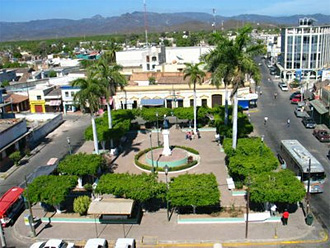Mexican Pacific Coast Tourism Project to Outshine Cancún
 Barnard R. Thompson - MexiData.info Barnard R. Thompson - MexiData.info
go to original


| | Escuinapa de Hidalgo, Sinaloa, México. | | |
The Mexican government has announced a major new tourism development that will stretch along the Pacific Ocean coast of southern Sinaloa – a project that will ultimately be twice the size of Cancún. A master planned tourist area to rival not just Cancún, but too the Riviera Maya that runs along the shores of the Mexican Caribbean.

President Felipe Calderón, with officials from the Mexican government`s National Trust Fund for Tourism Development (Fondo Nacional de Fomento al Turismo, or Fonatur), made the announcement at the September 29 opening of the Fonatur sponsored Mexican Real Estate and Tourism Investment Expo, in Mexico City.

Provisionally called the Pacific Coast Integrally Planned Center, infrastructure work is scheduled to begin during the first half of 2009, with the final stage of the phased developments to be completed by 2025. This in much the same way that other Fonatur master planned seaside resorts, such as Cancún, Los Cabos, Ixtapa, Loreto and the Bays of Huatulco, have been done.

The 5,884 acre [9.2 square miles] Pacific Coast CIP will be in the midst of the Sinaloa National Wetlands, in part on the near 5,000 acre Rancho Las Cabras, owned by former Sinaloa governor Antonio Toledo Corro. The area is 80 miles south of Mazatlán and west of the Mexico Highway 15 town of Escuinapa, in the municipality of the same name. On land between the Pacific Ocean and lagoons and marshes known as the Laguna Agua Grande, the area will include 7.5 miles of beaches between the villages of Isla del Bosque and Teacapán to the south on the State of Nayarit border.

The coastal area is well known locally for its beauty and tranquility. Slightly inland from the coast, the estuaries, lagoons and mangrove stands are surrounded by palm and tropical flora filled valleys, with a notable abundance of birds and migratory waterfowl. Deer, mountain lions and peccary, among other animals, are found in the area.

And fishing is big in the region, commercial fishing (and shrimp farming), and of course sportfishing. Several species of protected sea turtles come to area beaches, and at sea among the many species found are billfish, humpback whales and white sharks.

Of historical significance, there are large oyster shell mounds near Teacapán that experts say were harvested by indigenous peoples living in the area as long as 4,000 years ago.

The investment by the Mexican government is to be around MX$5 billion pesos [US$465 million as of September 29], according to President Calderón (who made the announcement before the current worldwide financial crises came to a head, and the anticipated cutbacks). Calderón added that the aforementioned Mexican public sector investment should spark another US$6.638 billion in private national and international investments.

First stage construction costs will be some MX$1.5 billion [US$139 million as of 9/29], according to a Fonatur executive, that will be applied to 988 acres. That first phase is scheduled for completion in 2012.

The President went on to say that the mega-development will ultimately create 78,000 direct and indirect jobs. He also said estimates are that the Pacific Coast CIP will attract nearly 3 million tourists by the year 2025, and US$2.8 billion in foreign exchange.

Once completed the overall complex is to include four golf courses; two marinas for a total of 1,000 vessels; 44,200 hotel rooms (hotels, condominiums, etc.); a five mile beachfront walk; and a light railway. Plus the possibility of a new airport is in the offing (or the small airport at Teacapán could be expanded).

Based on what has been learned from other CIPs, such as Cancún, hotels will not be allowed right on the beach. The required buffer zone will be 300 meters. Hotels will also have a maximum height limit of four stories.

Urban zones and shopping areas will integrate open space shielded by law against construction, as will cultural centers and convention facilities.

Emphasis will be placed on nature and the environment, with 25 percent of the total 5,884 acres dedicated as natural protected areas, acreage that must be devoid of development. Furthermore, 109 acres of the surrounding wetland environs will be kept intact. Regarding the lagoon and marsh areas, visitors will be able to enjoy ecotourism activities via a series of canals and pathways.

As well, Pacific Coast CIP developments will have to meet marine and land area environmental standards and requisites that are included in the 2006 Marine Ecological Ordinance of the Gulf of California Program.

For workers, at least 5,000 homes will be built, along with schools, hospitals and facilities for needed community services.

Water will be provided through three separate systems, wastewater treatment plants will be built, and each hotel will have to install not only rainwater catchment receptacles, but too separate systems for rain and wastewater drainage and control.

On an interconnected regional basis, highway improvements are planned for the stretch of Highway 15 from Mazatlán south to Tepic, Nayarit (and on to Tequila and Guadalajara; or southwest to the Bahía de Banderas-Compostela Tourist Corridor and Puerto Vallarta). Too, the road inland from Mazatlán to Durango is to be improved, all arteries that will give area visitors, among others, easier access to tourist and cultural sites, neighboring cities, mountain regions, archeological zones, and indigenous communities.

And finally, for ocean going visitors, the Pacific Coast CIP is to be in harmony with Fonatur`s Sea of Cortez Plan, the system of Transient Marinas, and the so-called Nautical Staircase.

Barnard Thompson, editor of MexiData.info, has spent 50 years in Mexico and Latin America, providing multinational clients with actionable intelligence; country and political risk reporting and analysis; and business, lobbying, and problem resolution services. |



